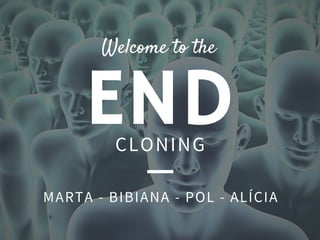Welcome 2
- 1. END Welcome to the C L O N I N G M A R T A - B I B I A N A - P O L - A L ? C I A
- 2. GUIDE The Survival S T E P O N E
- 3. CLONING What is C L O N E S A R E O R G A N I S M S T H A T A R E E X A C T G E N E T I C C O P I E S
- 4. ARTIFICIAL EMBRYO TWINNING This technique mimics the natural process that creates identical twins. SOMATIC CELL NUCLEAR TRANSFER It is a totally different technique than the artificial embryo twinning but it produces the same exact result, two identical embryos
- 5. GUIDE The Survival S T E P T W O
- 6. VS Therapeutic cloning G O A L S A N D T E C H N I Q U E S Reproductive cloning
- 7. REPRODUCTIVE CLONING A copy of another human being is created through SCNT, allowed to grow up to 14 days in a petri dish, and then transplanted into a womb to grow until birth THERAPEUTIC CLONING When cloned embryos created through SCNT are allowed to grow for a few days and then killed for their stem cells
- 8. GUIDE The Survival S T E P T H R E E
- 9. USES & RISKS Potential I T 'S Y O U R T U R N T O T H I N K
- 10. USES Cloning in Medicine Cloning livestock RISKS Failure Rate Problems during later development Abnormal gene expression patterns
- 11. GUIDE The Survival S T E P F O U R
- 12. ISSUES Ethical I T 'S Y O U R T U R N T O T H I N K
- 13. RELIGIOUS BELIEF AND CONTROL Humans cannot act as "God" MORAL BELIEF It is wrong for any human to have control over the genetic make up of any other individual
- 14. READY Get I T H A S S T A R T E D M A R T A - B I B I A N A - P O L - A L ? C I A













